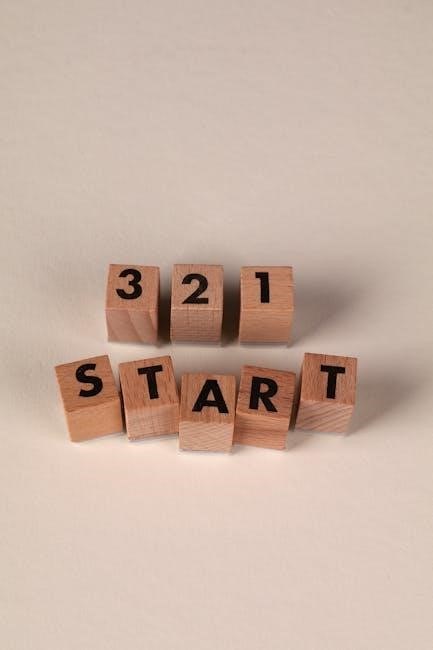ECERS-3 is the latest edition of the Early Childhood Environment Rating Scale, a widely used tool for assessing the quality of educational environments in early childhood settings․ It provides a comprehensive framework for evaluating various aspects of classroom environments, including space, materials, and interactions, to support optimal child development․ The scale is designed to help educators and caregivers create nurturing and effective learning spaces․ ECERS-3 builds on previous versions, incorporating updated research and best practices in early childhood education․ Its implementation is supported by detailed manuals, checklists, and training resources, making it a valuable tool for improving educational quality worldwide;
1․1 Overview of ECERS-3
ECERS-3 is a comprehensive assessment tool designed to evaluate the quality of early childhood education environments․ It focuses on six key subscales: Space and Furnishing, Supervision and Care, Language and Literacy, Activities, Interaction, and Program Structure․ Each subscale provides detailed criteria to measure the effectiveness of classroom environments in supporting children’s development․ The tool emphasizes the importance of a well-organized, safe, and engaging space that fosters learning and social interaction․ ECERS-3 also highlights the role of materials and resources in creating a stimulating environment․ By providing clear guidelines, it helps educators and caregivers improve the quality of educational settings, ensuring children have access to optimal learning opportunities․
1․2 Historical Development of ECERS
The Early Childhood Environment Rating Scale (ECERS) was first developed in the late 20th century as a tool to assess the quality of preschool environments․ Created by Thelma Harms, Richard Clifford, and Elizabeth Cryer, the original ECERS focused on evaluating classroom environments to support young children’s development․ Over the years, the scale underwent revisions to reflect evolving research and educational practices․ The third edition, ECERS-3, emerged as a refined and updated version, incorporating contemporary understanding of early childhood education․ Its development was influenced by extensive research and feedback from educators worldwide․ Today, ECERS-3 is internationally recognized as a benchmark for evaluating and improving early childhood educational settings․

Key Features of ECERS-3
ECERS-3 is a comprehensive assessment tool evaluating early childhood educational environments through six subscales, updated criteria, and alignment with best practices to support optimal child development․
2․1 Structure and Subscales
ECERS-3 is organized into six subscales, each assessing a critical aspect of early childhood environments․ These subscales include Space and Furnishing, Supervision and Care, Language and Literacy, Activities, Interaction, and Program Structure․ Each subscale contains specific items that evaluators observe and rate on a scale, providing a comprehensive overview of the environment’s quality․ The structure ensures a holistic evaluation, covering physical arrangements, caregiving practices, educational activities, and social interactions․ This organized approach allows educators to identify strengths and areas for improvement, ensuring a supportive and enriching environment for young learners․ The subscales are interconnected, reflecting the complexity of early childhood educational settings․
2․2 Updates in the Third Edition
ECERS-3 introduces several updates to enhance its effectiveness as a tool for assessing early childhood environments․ The third edition incorporates revised subscales and items to reflect current research and best practices in early childhood education․ It places greater emphasis on diversity, inclusion, and culturally responsive practices, ensuring the scale is more equitable and relevant for diverse settings․ Additionally, the updated version includes new indicators for assessing the quality of interactions and the use of materials in promoting learning․ These changes aim to provide a more comprehensive and accurate evaluation of educational environments, supporting improved outcomes for young children․ The updates also align with contemporary educational standards and practices․

Subscales of ECERS-3
ECERS-3 consists of six subscales evaluating key aspects of early childhood environments, including space, supervision, language, activities, interaction, and program structure, ensuring a holistic assessment․

3․1 Space and Furnishing

The Space and Furnishing subscale evaluates the physical environment, ensuring it is safe, well-organized, and conducive to learning․ It assesses the availability of appropriate furniture, storage, and materials․ Comfortable seating, such as cushions or chairs, is essential, with recommendations like 3-4 large or 6-8 small cushions for a group of 25 children․ The space should encourage movement and exploration while maintaining a clutter-free, child-friendly layout․ Additional criteria include the presence of shelves for toys and materials, ensuring accessibility and promoting independence․ This subscale emphasizes the importance of a welcoming and functional environment that supports children’s physical and educational needs, aligning with best practices in early childhood education․
3․2 Supervision and Care
The Supervision and Care subscale assesses the quality of adult-to-child interactions and caregiving practices․ It evaluates whether staff provide consistent, sensitive, and responsive supervision, ensuring children’s safety and well-being․ Key indicators include appropriate adult-to-child ratios, staff qualifications, and the quality of care during routines like toileting or feeding․ The subscale also examines how staff engage with children, fostering a sense of security and trust․ Additionally, it considers the availability of health and safety practices, such as proper handwashing and injury prevention․ This subscale emphasizes the importance of a nurturing environment where children feel protected and supported, with caregivers actively promoting their physical and emotional needs․ Effective supervision and care are critical for children’s overall development and well-being․
3․3 Language and Literacy
The Language and Literacy subscale evaluates the quality of language and literacy experiences provided to children․ It assesses how staff engage children in conversations, encourage verbal interaction, and promote language development․ This subscale also examines the availability and use of age-appropriate books, writing materials, and opportunities for storytelling or reading aloud․ Additionally, it considers how the environment supports early literacy skills, such as recognizing letters, understanding print, and engaging in wordplay․ The subscale emphasizes the importance of creating a language-rich environment that fosters children’s communication skills and prepares them for future academic success․ Materials and activities should reflect diversity and inclusivity, ensuring all children feel represented and engaged in literacy practices․
3․4 Activities
The Activities subscale evaluates the quality and variety of experiences provided to children, focusing on fine motor, art, imaginative play, and science/math activities․ It assesses how well activities promote learning, engagement, and creativity․ Materials such as puzzles, art supplies, and dramatic play materials are reviewed for availability and accessibility․ The subscale also considers how activities are tailored to children’s developmental levels and interests․ Staff encouragement of children’s participation and exploration is a key criterion․ The scale emphasizes the importance of providing diverse and stimulating experiences that foster cognitive and creative development․ Activities should align with children’s natural curiosity and support their ability to explore and learn through play․ This subscale ensures that activities are engaging, age-appropriate, and inclusive for all children․
3;5 Interaction
The Interaction subscale assesses the quality of interactions between teachers and children, focusing on verbal communication, emotional support, and social interactions․ It evaluates how teachers encourage children’s language development, foster empathy, and promote positive relationships․ The subscale also examines how teachers support children’s independence and conflict resolution skills․ Key criteria include positive verbal interactions, sensitivity to children’s needs, and the use of encouraging and supportive language․ The subscale emphasizes the importance of creating a nurturing environment where children feel secure and valued․ By evaluating these interactions, ECERS-3 helps identify strengths and areas for improvement in teacher-child relationships, ultimately enhancing the overall quality of care and education․ This subscale is crucial for fostering social-emotional development and collaboration in early childhood settings․
3․6 Program Structure
The Program Structure subscale in ECERS-3 evaluates the organization and planning of daily routines, transitions, and activities to ensure they are developmentally appropriate and engaging for children․ It assesses the clarity and predictability of schedules, the balance between structured and unstructured time, and the effectiveness of transitions․ This subscale also considers how activities are sequenced to promote learning and maintain children’s interest․ Key criteria include the presence of a daily schedule, opportunities for child-initiated play, and the use of transitions that minimize disruptions․ A well-structured program fosters a sense of security and supports children’s social, emotional, and cognitive development․ ECERS-3 highlights the importance of intentional planning to create a cohesive and engaging educational environment․ This subscale helps identify strengths and areas for improvement in program organization, ensuring optimal learning experiences for young children․

Importance of ECERS-3 in Early Childhood Education
ECERS-3 enhances educational quality by evaluating learning environments, care, and interactions, ensuring they support child development․ It aids in informed decision-making and continuous improvement in early childhood education․
4․1 Role in Quality Assessment
ECERS-3 plays a pivotal role in quality assessment by providing a structured framework to evaluate early childhood environments․ It helps identify strengths and areas needing improvement, ensuring alignment with research-based standards․ The tool assesses various domains, such as space, materials, and interactions, to determine the overall quality of care and education․ By using ECERS-3, educators can make data-driven decisions to enhance learning environments, ultimately benefiting child development․ This systematic approach supports accountability and continuous improvement in early childhood education settings, making it a vital resource for ensuring high-quality care and education․
4․2 Impact on Educational Outcomes
ECERS-3 significantly influences educational outcomes by ensuring environments that support optimal child development․ High-quality settings, as assessed by ECERS-3, are linked to improved cognitive, social, and emotional skills in children․ The scale emphasizes the importance of literacy-rich environments, engaging activities, and supportive interactions, which are critical for fostering early learning․ By identifying and addressing gaps in educational environments, ECERS-3 helps educators create spaces that promote academic readiness and socio-emotional growth․ Research indicates that classrooms meeting ECERS-3 standards often see better long-term educational outcomes, including enhanced language skills, problem-solving abilities, and social interactions․ This tool is essential for shaping environments that lay a strong foundation for future success․

Implementation and Use of ECERS-3
ECERS-3 is implemented through observational assessments, supported by detailed manuals, checklists, and training programs․ It guides educators in evaluating and improving classroom environments to enhance learning experiences for young children․ Administrators and teachers use these tools to identify strengths, address gaps, and align practices with research-based standards, ensuring high-quality education and care․ Regular training and professional development are essential for effective use of ECERS-3 in early childhood settings․ This systematic approach helps create environments that foster holistic child development and prepare children for future academic success․
5․1 Best Practices for Administrators
Administrators play a crucial role in successfully implementing ECERS-3 by fostering a supportive environment for teachers and caregivers․ They should prioritize professional development, ensuring staff receive training on ECERS-3 tools and guidelines․ Regularly reviewing materials checklists and ensuring classrooms meet quality indicators is essential․ Encouraging collaborative reflection among teachers and providing resources for continuous improvement are key strategies․ Administrators should also establish clear goals aligned with ECERS-3 standards and monitor progress through periodic assessments․ By promoting a culture of accountability and innovation, administrators can enhance the overall quality of early childhood education․ Effective communication and transparency in implementing ECERS-3 practices will lead to better educational outcomes for children․
5․2 Challenges in Implementation
Implementing ECERS-3 can present several challenges for early childhood education settings․ One common issue is the need for significant resources and budget allocations to meet the scale’s quality indicators; Additionally, staff may require extensive training to fully understand and apply the ECERS-3 framework effectively․ Time constraints are another challenge, as continuous observation and documentation can be labor-intensive․ Ensuring consistency across all classrooms and maintaining the balance between structure and flexibility in daily routines can also be difficult․ Furthermore, adapting ECERS-3 to diverse cultural and linguistic settings may require additional effort․ Addressing these challenges requires strong leadership, ongoing support, and a commitment to improving educational quality․ Open communication and collaboration among stakeholders are essential for successful implementation․

Materials and Resources for ECERS-3
The ECERS-3 Materials Checklist provides detailed criteria for evaluating educational materials, ensuring they align with quality standards․ Additional tools, such as manuals and guides, support effective implementation and improvement of early childhood environments․
6․1 Materials Checklist
The ECERS-3 Materials Checklist is a comprehensive tool designed to evaluate the quality and appropriateness of materials in early childhood education settings․ It covers various aspects such as furniture, toys, art supplies, and educational resources․ The checklist provides specific criteria to ensure materials are safe, durable, and age-appropriate, fostering learning and development․ It also emphasizes the importance of diversity in materials to reflect different cultures and abilities․ By using this checklist, educators can assess their current resources and identify areas for improvement․ This tool is essential for creating an enriching environment that supports children’s cognitive, social, and emotional growth․ Regular updates ensure it remains aligned with best practices in early childhood education․
6․2 Additional Tools and Guides
ECERS-3 is supported by a variety of additional tools and guides to enhance its implementation and effectiveness․ These include detailed manuals, research-based articles, and training materials that provide deeper insights into best practices․ The manuals offer step-by-step instructions and examples to help educators accurately assess and improve classroom environments․ Research articles highlight the impact of ECERS-3 on educational outcomes and provide evidence-based strategies for enhancing quality․ Training materials, such as workshops and webinars, are also available to support professional development․ These resources ensure that educators and administrators can maximize the benefits of ECERS-3, creating high-quality learning environments that foster children’s development and success․

Case Studies and Research
ECERS-3 has been validated through extensive research and case studies, demonstrating its effectiveness in improving early childhood education․ Studies highlight successful implementations and measurable outcomes․
7․1 Successful Implementation Examples
ECERS-3 has been successfully implemented in various early childhood education settings worldwide․ In Saipan and Tinian, caregivers attended training series, improving classroom quality․ A Russian study highlighted improved program structure and interaction after ECERS-3 adoption․ For instance, adding 3-4 large pillows or 6-8 small ones enhanced comfort, aligning with ECERS-3 standards․ These examples demonstrate how ECERS-3 tools and guidelines can transform educational environments, fostering better outcomes for children․ Such implementations underscore the scale’s effectiveness in promoting high-quality care and education globally․
7․2 Research Findings
Research on ECERS-3 highlights its effectiveness in improving early childhood education quality․ Studies across over 20 countries demonstrate that higher ECERS-3 scores correlate with better developmental outcomes for children․ For instance, classrooms with strong ratings in space and interaction showed significant gains in children’s cognitive and social skills․ The scale’s focus on materials and program structure has been linked to enhanced learning environments․ ECERS-3’s alignment with modern educational practices, such as fostering language development and structured activities, is supported by extensive research․ These findings underscore the tool’s reliability and validity in assessing and improving early childhood education settings globally․

Training and Professional Development
ECERS-3 offers workshops and training programs to help educators understand and implement its framework effectively․ These resources provide hands-on activities and expert guidance to enhance teaching skills and classroom quality․
8․1 Workshops and Training Programs
ECERS-3 workshops and training programs are designed to equip educators with the skills to effectively use the scale for improving classroom environments․ These sessions provide expert guidance, hands-on activities, and real-world examples to enhance understanding․ Participants learn how to assess and improve classroom setup, materials, and teacher-child interactions․ Workshops also focus on aligning practices with ECERS-3 indicators, fostering a supportive and engaging learning environment․ Additionally, these programs emphasize professional growth, helping educators integrate research-based strategies into their daily practices․ By attending these workshops, educators gain the tools and confidence to create high-quality educational settings that promote child development and learning outcomes․
8․2 Role of Teachers and Caregivers
Teachers and caregivers play a vital role in implementing ECERS-3 standards, as they are directly responsible for creating and maintaining a high-quality educational environment․ Their primary responsibilities include fostering positive interactions, ensuring effective supervision, and organizing materials to support learning․ They must also promote activities that encourage children’s cognitive, social, and emotional development․ By adhering to ECERS-3 criteria, educators can assess and improve classroom practices, ensuring alignment with best practices in early childhood education․ Their active engagement in professional development and continuous self-reflection further enhances their ability to provide nurturing and stimulating environments for young learners․ Their dedication is crucial for achieving the goals outlined in the ECERS-3 framework․
